
A shrub is a small- to medium-sized perennial woody plant. Unlike herbaceous plants, shrubs have persistent woody stems above the ground. Shrubs can be deciduous or evergreen. They are distinguished from trees by their multiple stems and shorter height, less than 6–10 m (20–33 ft) tall. Small shrubs, less than 2 m (6.6 ft) tall are sometimes termed subshrubs.

A vine is any plant with a growth habit of trailing or scandent stems, lianas or runners. The word vine can also refer to such stems or runners themselves, for instance, when used in wicker work.

Jasmine is a genus of shrubs and vines in the olive family (Oleaceae). It contains around 200 species native to tropical and warm temperate regions of Eurasia and Oceania. Jasmines are widely cultivated for the characteristic fragrance of their flowers. A number of unrelated plants contain the word "jasmine" in their common names.

The Caprifoliaceae or honeysuckle family is a clade of dicotyledonous flowering plants consisting of about 860 species in 42 genera, with a nearly cosmopolitan distribution. Centres of diversity are found in eastern North America and eastern Asia, while they are absent in tropical and southern Africa.
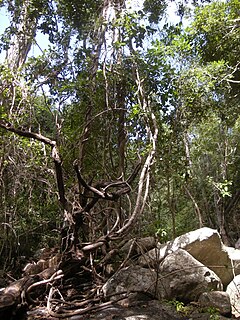
A liana is a long-stemmed, woody vine that is rooted in the soil at ground level and uses trees, as well as other means of vertical support, to climb up to the canopy in search of direct sunlight. The word liana does not refer to a taxonomic grouping, but rather a habit of plant growth – much like tree or shrub. It comes from standard French liane, itself from an Antilles French dialect word meaning to sheave.

Linaceae is a family of flowering plants. The family is cosmopolitan, and includes about 250 species in 14 genera, classified into two subfamilies: the Linoideae and Hugonioideae. Leaves of the Linaceae are always simple; arrangement varies from alternate to opposite or whorled. The hermaphroditic, actinomorphic flowers are pentameric or, very rarely, tetrameric.
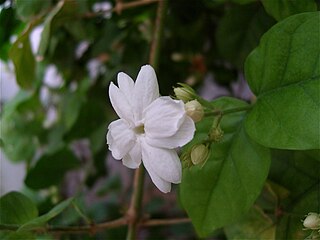
Jasminum sambac is a species of jasmine native to tropical Asia, from the Indian subcontinent to Southeast Asia. It is cultivated in many places, especially across much of South and Southeast Asia. It is naturalised in many scattered locales: Mauritius, Madagascar, the Maldives, Christmas Island, Chiapas, Central America, southern Florida, the Bahamas, Cuba, Hispaniola, Jamaica, Puerto Rico, and the Lesser Antilles.
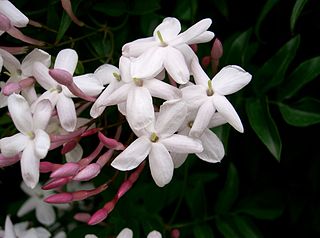
Jasminum polyanthum, the many-flowered jasmine or pink jasmine, is a species of flowering plant in the olive family Oleaceae, native to China and Myanmar. A strong evergreen twining climber, it is especially noted for its abundant, highly fragrant pink to white flowers.

Jasminium dichotomum, the Gold Coast jasmine, is a species of jasmine, in the family Oleaceae. It is an evergreen climber which grows as a rambling shrub or woody vine. The flowers are quite fragrant and open at night, coloured pink when budding then white; these appear at the leaf axils in cluster. It blooms year round. The leaves are opposite. The fleshy fruit is small.

Jasminum grandiflorum, also known variously as the Spanish jasmine, Royal jasmine, Catalan jasmine, among others, is a species of jasmine native to South Asia, the Arabian peninsula, East and Northeast Africa and the Yunnan and Sichuan regions of China. The species is widely cultivated and is reportedly naturalized in Guinea, the Maldive Islands, Mauritius, Réunion, Java, the Cook Islands, Chiapas, Central America, and the Caribbean.It is closely related to, and sometimes treated as merely a form of, Jasminum officinale. The plant is known as "saman pichcha" or "pichcha" in Sri Lanka.

Jasminum officinale, known as the common jasmine or simply jasmine, is a species of flowering plant in the olive family Oleaceae. It is native to the Caucasus, northern Iran, Afghanistan, Pakistan, the Himalayas, Tajikistan, India, Nepal and western China. The species is also widely cultivated in many places, and is reportedly naturalized in Spain, France, Italy, Portugal, Romania, Croatia, Bosnia and Herzegovina, Montenegro, Serbia, Algeria, Florida and the West Indies.

Jasminum multiflorum, commonly known as star jasmine, is a species of jasmine, in the family Oleaceae.
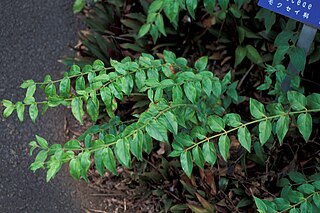
Jasminum multipartitum, the starry wild jasmine, African jasmine, or imfohlafohlane, is a species of jasmine, in the family Oleaceae, that is native to Southern Africa.

Jasminum didymum is a species of scrambling vine or low shrub. It is native to insular Southeast Asia from Java to the Philippines, as well as Australia, as well as some islands in the Pacific. Jasminum didymum occurs naturally in habitats from rainforests to arid and semi-arid shrublands.
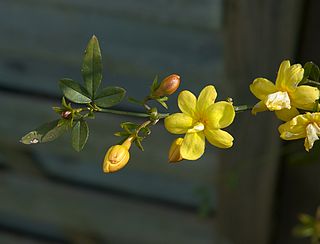
Jasminum mesnyi, the primrose jasmine or Japanese jasmine, is a species of flowering plant in the family Oleaceae, native to Vietnam and southern China. It is also reportedly naturalized in Mexico, Honduras and parts of the southern United States.

Jasminum azoricum, the lemon-scented jasmine, is a species of flowering plant in the olive family. It is an evergreen twining vine native to the Portuguese island of Madeira. The compound leaves consist of 3 bright green leaflets. The fragrant white star-shaped flowers appear in panicles from the leaf axils in summer, evolving from deep pink buds.

Jasminum angustifolium, the wild jasmine, is a species of jasmine native to India, Sri Lanka and the Andaman Islands. It is a climbing shrub with a smooth stem and minutely pubescent branchlets. The flowers are approximately 1 inch in diameter, and resemble a star with 7 or 8 narrow petals, flowering between June and August.
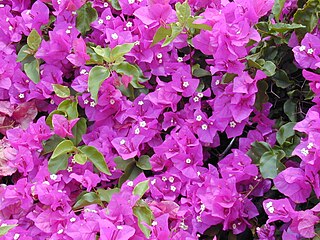
Bougainvillea spectabilis, also known as great bougainvillea, is a species of flowering plant. It is native to Brazil, Bolivia, Peru, and Argentina's Chubut Province.

Muellerina myrtifolia, common name myrtle-leaved mistletoe, is a hemiparasitic arial shrub in the family Loranthaceae. The species is endemic to New South Wales and Queensland.
Australian Tropical Rainforest Plants, also known as RFK, is an identification key giving details—including images, taxonomy, descriptions, range, habitat, and other information—of almost all species of flowering plants found in tropical rainforests of Australia, with the exception of most orchids which are treated in a separate key called Australian Tropical Rainforest Orchids. A key for ferns is under development. RFK is a project initiated by the Australian botanist Bernie Hyland.



















